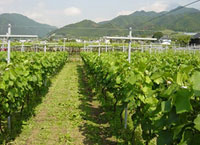|
|
|||||||
|
|
|||||||
|
|||||||
| | Web Japan >>| Trends in Japan >> | Lifestyle >> | In the Zone | |
|
IN THE ZONE Structural Reform Zones Bring New Opportunities (July 10, 2003)
Taking Classes in English Looking at the special zones approved in the first round, the largest number, 23 in total, deal with tie-ups between industry and academia. Other fields include education (17 projects), international distribution (15), exchange between cities and farming villages (14), agriculture (13), social welfare (13), industrial promotion (12), combining day care centers and kindergartens (6), and promoting information technology (4). Many of these projects are quite unique. With the cooperation of residents, Ota City in Gunma Prefecture has begun work on establishing an integrated private elementary, middle, and high school at which all the classes with the exception of Japanese will be taught in English. The goal is to nurture internationally minded people via progressive English-language education, and the school is scheduled to open in April 2005. For its inaugural year, the school is seeking 60 first-year students (two classes) and 30 fourth-year students (one class). The town of Kaifu in Tokushima Prefecture, meanwhile, is embarking on a program in which the town itself will employ elementary- and middle-school teachers directly rather than receive them from the prefecture. Because the teachers will be employees of the town, they will have to live there. The advantage of this project is that it will link the schools with the community and foster interaction between the students and other townspeople, such as through classes in which the students can experience the unique characteristics of the area.
Grapes and Olives A project in the city of Kitakyushu involves an "international distribution special zone" featuring 24-hour customs and quarantine services and a relaxation of the rules governing the supply of electricity. The cost of electric power will be reduced in order to promote the entry of new firms. As for the 24-hour customs service, after-hours customs procedures are already being offered on a trial basis at the Tachinoura Container Terminal, and, following the approval of the special zone, the local authorities are asking the central government to extend this to the Kokura Container Terminal. A number of special zones aim to promote products unique to a specific region. Wine has become quite popular in Japan in recent years, and Yamanashi Prefecture is the oldest wine-producing region in Japan, accounting for about 40% of domestic production. It is said that creating a fine wine requires growing excellent grapes, but even though the quality of the grapes can make or break a wine, wineries in Japan have previously not been permitted to own vineyards and grow their own grapes. In fact, corporations are barred from engaging in farming in Japan. A special zone in Yamanashi Prefecture, though, will allow wineries to lease idle farmland, thus bringing grape cultivation and wine production together. This will enable them to produce higher-quality wine and will spark tourism by allowing visitors to view the entire wine-production process. Another unique project is taking place in the town of Uchinomi on the island of Shodoshima in Shikoku's Kagawa Prefecture. Shodoshima is the only olive-growing region in Japan, and the goal of the special zone there is to promote the area to the rest of Japan as a tourist destination. The town will borrow a large tract of idle farmland and lease portions of it to businesses, and the entire process of olive production, from cultivation to the sale of commercial products, will be on display for visitors. The government plans to create an evaluation committee that will judge the effectiveness of special zones and determine whether similar deregulation should take place across the entire country. There are high hopes that these special zones could help to trigger economic revitalization not only in the regions where they are located but in the nation as a whole. Related Web Sites"special zones for structural reform" in Prime Minister of Japan and His Cabinet Fukuoka Prefecture city of Kitakyushu Yamanashi Prefecture town of Uchinomi Copyright (c) 2004 Web Japan. Edited by Japan Echo Inc. based on domestic Japanese news sources. Articles presented here are offered for reference purposes and do not necessarily represent the policy or views of the Japanese Government. |
KOIZUMI RESHUFFLES CABINET (October 8, 2002) TRENDIEST PHRASES OF 2001 (January 22, 2002) |
|||||||
|
||||||||



